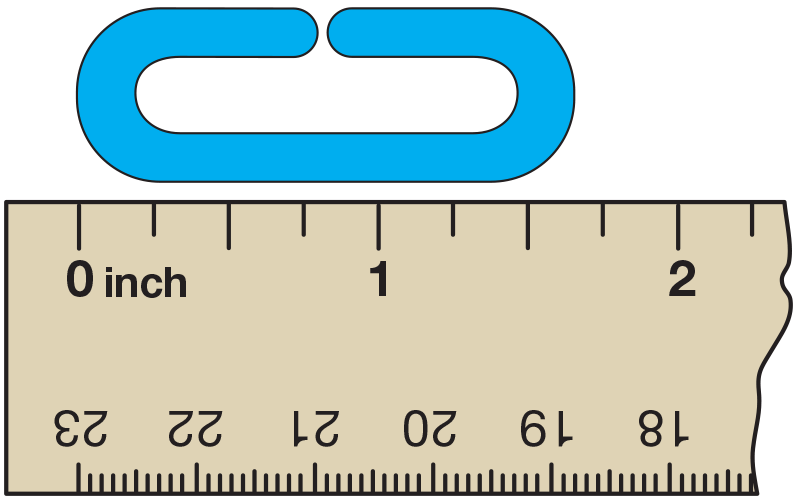Distribute one ruler from the 10-Inch Ruler Master per student and display one for the class.
- Let's think about inches now. How many inches are on this ruler? (10 inches)
- Is this ruler longer or shorter than the rulers you
have used before? (shorter; It is only 10 inches long
and we have used 12-inch rulers.)
- Compare this 10-link chain to your 10-inch ruler.
What do you find? (The 10-link chain is longer than
the 10-inch ruler.)
- Do you think the length of a link is longer than or
shorter than an inch? Why do you think so?
(Possible response: longer; If a 10-link chain is
longer than a 10-inch ruler, I think one link would
be longer than one inch.)
- How can you find out? (Possible response: Measure
a link with a ruler.)
- Use your ruler to measure one link. What do you
find? (A link is a little longer than one inch. See
Figure 4.)
- Does this make sense? Why or why not? (Possible
response: It makes sense because one link is longer
than one inch, so 10 links should be longer than
10 inches.)
- [Student name]'s height was [38] links. If we measure
[student name] in inches, will [his or her] height be
more than [38] inches? Explain. (Yes, the measurement
will be more than [38] inches. Inches are
shorter than links, so we will need more inches to
make the same length in links.)
- What is a good guess for [student name]'s height in
inches? (Estimates in inches should be greater than
the quantity of links.)
- Let's measure [student name]'s height with a 10-inch
ruler.
Ask a volunteer or a pair of volunteers to measure the
student in inches. Additional volunteers can measure to
verify the measurement. Students can count by tens
and count on the additional inches.
Discuss how the measure of height is dependent on the
size of the unit of measure. Since inches are smaller
than links, the quantity of inches in the student's height
should be greater than the quantity of links.
- [Student name]'s height was [38] links and [50]
inches. Could be or crazy? Does this make sense?
(Yes, this could be. It takes more inches than links
to represent the height.)
- The length of the desk was [49] links. Would its
length be more than or less than [49] inches? (more
than [49] inches)
- What is a good guess for length of the desk in
inches? (The estimate should reflect a greater quantity
of inches than the quantity of links.)
Ask student pairs to determine an estimate, and then
have them record the estimate on a piece of paper.
Have a volunteer or a pair of volunteers measure the
desk's actual length in inches. Additional volunteers
can verify the measurement. Display the measurement
and ask students to compare their estimates to the
actual measurement. Encourage them to use the number
lines in the classroom to aid in comparison.
- Think about your own estimate. Is your estimate
larger than the actual measurement? Smaller than
the actual measurement?
- Is your estimate close enough to the actual measurement?
Is it a "could be" estimate or a "crazy" estimate?













